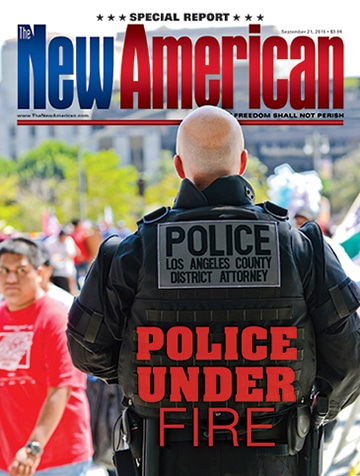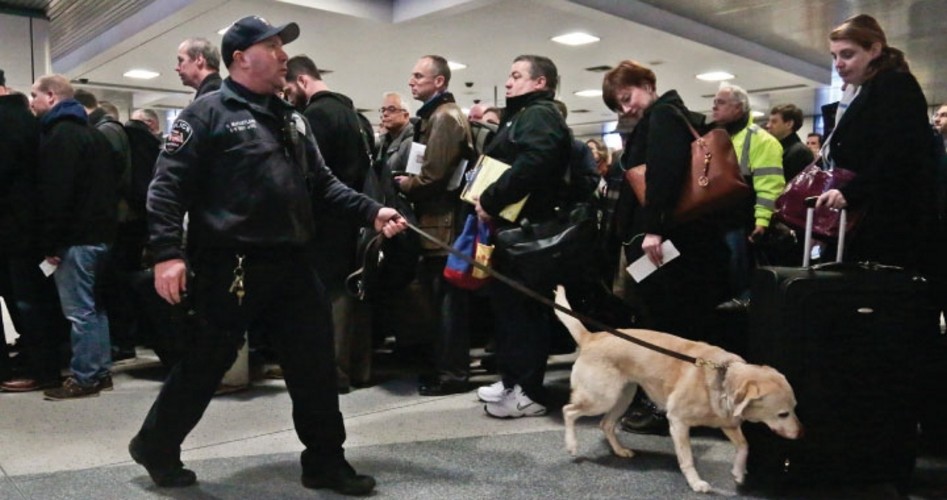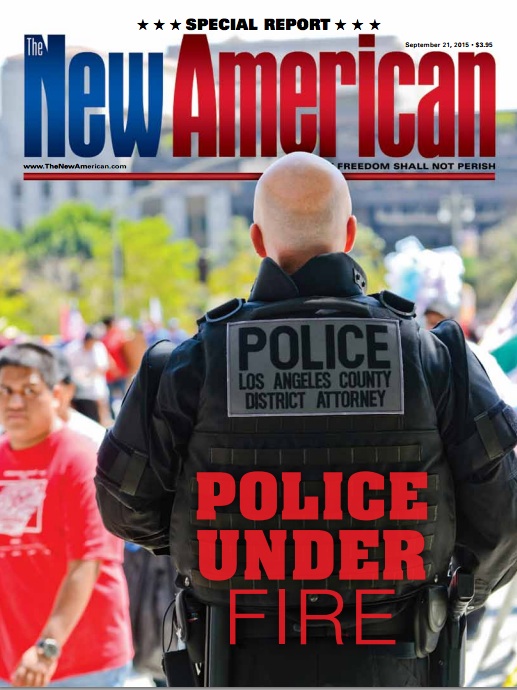What’s Happening to Our Police?
The federal government has been busy creating unconstitutional agencies co-opting policing while simultaneously using a “carrot and stick” approach — unconstitutional federal aid and federal mandates — to absorb and coerce the local police, transforming them into instruments of an emerging national police force.
This subversive transformation of America’s way of policing has been under way for a long time. The American ideal of local police — locally funded and locally controlled — whose job it is to protect the public against violent and fraudulent criminal elements that will always be found in every society, is being radically changed. Over the past decade, this process has accelerated dramatically, with every terrorist incident, riot, police shooting, or upsurge in criminal activity serving as an excuse to further nationalize.
All of us who fly have become accustomed (willing or otherwise) to TSA pat-downs, body scans, interrogations, and other indignities and violations. That is part of the political fallout of the September 11, 2001 terrorist attacks: the birth of another federal agency, the Transportation Security Administration, TSA. But as is always the case with government, it seems, it did not take long for mission creep to set in. Federal Homeland Security officials soon had TSA units in black military gear leading multiple federal and local agencies in police sweeps of Amtrak and Greyhound bus stations, as well as other “transportation infrastructure” nationwide. By 2011, according to TSA chief John Pistole in testimony to Congress, the TSA was carrying out more than 8,000 of these sweeps a year.
But the TSA’s stupendous growth and reach within the span of a decade represents only a fraction of the spiraling federal police state presence. Virtually every federal agency now has its own SWAT-style paramilitary “police” unit to enforce its edicts and “protect the homeland”: the Departments of State, Education, Agriculture, Energy, and Treasury, for instance, and agencies such as the Environmental Protection Agency, the Food and Drug Administration, the Social Security Administration, the National Park Service, the U.S. Fish and Wildlife Service, the Forest Service, the Bureau of Land Management, etc. Not to mention the U.S. Marshals Service, the FBI, the Federal Protective Police Service, U.S. Customs and Border Patrol, and the Bureau of Alcohol Tobacco, Firearms, and Explosives.
There are now tens of thousands of federal “police” running around in an assortment of uniforms, even though the U.S. Constitution provides no authority for — and in fact prohibits — any such federal police agencies. Congress doesn’t even know how many of these rogue units are out there operating. In an attempt to get some handle on this matter, Representative Chris Stewart (R-Utah) introduced, in 2014, the Regulatory Agency Demilitarization Act (H.R.4934) directing the U.S. Comptroller General to submit an annual report to Congress providing details on the number and description of SWAT-style units of federal regulatory agencies and their weapons, training, and purpose. The bill has 31 cosponsors but has gone nowhere in the GOP-controlled House; Republicans have been as blasé toward the dangers of a national police state as have Democrats.
Just as important as, if not more important than, this burgeoning federal police-state apparatus are the various means by which federal politicians and bureaucrats are transforming our local police into fedgov adjuncts by coopting them with grants, equipment, and training. The FBI Academy in Quantico, Virginia, for example, trains thousands of local peace officers and law-enforcement executives. Less well known are the Federal Law Enforcement Training Centers (FLETC), which, according to the FLETC website, “provide tuition-free and low cost training to state, local, campus, tribal and territorial law enforcement agencies. Programs are conducted across the United States and are normally hosted by a local law enforcement agency. Training is also conducted at FLETC facilities located in Glynco (Brunswick), GA; Artesia, NM; Charleston, SC; and Cheltenham, MD.”
Although these programs predate his administration, President Obama has been moving full speed ahead for nationalization and militarization of America’s local law enforcement. Indeed, he has done more to militarize law enforcement and transferred more weapons and military equipment to local law enforcement than perhaps any other president in U.S. history. When the riots and violence broke out in Ferguson, Missouri, following the police shooting of Michael Brown, many television viewers nationwide were as alarmed by the fearsome images of armored military vehicles and police in military gear as by the scenes of rioting and looting. Incredibly (but true to form, nevertheless), in his August 14, 2014 press conference, President Obama denounced the Ferguson police response. And he warned, “There is a big difference between our military and our local law enforcement, and we don’t want those lines blurred,” as though he had had nothing to do with blurring those lines. Likewise, Obama’s liberal Democratic sidekick in Missouri, Governor Jay Nixon, claimed he was “thunderstruck” by the sight of police in military gear on the streets of Ferguson. But only a few months earlier, Governor Nixon himself had signed off on delivery of the military equipment to Missouri police.
President’s Task Force
At a May 2015 press conference in Camden, New Jersey, President Obama announced plans to implement recommendations laid out by the “President’s Task Force on 21st Century Policing,” a multi-agency body that he had created by decree to examine law-enforcement issues. Unsurprisingly, the outfit recommended national “standards” for police, and much more, be implemented at state and local government levels, using unconstitutional federal bribes as a primary mechanism.
The new set of rules on military gear endorsed by Obama reportedly does include rolling back, if only slightly, a 25-year-old federal program established under Section 1033 of the National Defense Authorization Act (NDAA) used to militarize local police with “surplus” war-fighting tools. But his administration has previously used that authority to expand police militarization to unprecedented levels, even while attacking gun rights of American citizens and claiming “weapons of war” do not belong in the hands of civilians.
“We’ve seen how militarized gear can sometimes give people a feeling like there’s an occupying force as opposed to a force that’s part of the community that’s protecting them and serving them,” Obama said at his speech in Camden, which employed a backdrop of police officers in uniform. “It can alienate and intimidate local residents and send the wrong message.” But it is the fedgov military gear and the adversarial attitude instilled by fedgov training that are alienating local citizens.
The measures Obama has taken toward reining in federal distribution of certain types of military equipment to local police forces include limiting the dispersal of vehicles that use tank-style tracks instead of wheels, bayonets, weaponized aerial vehicles, certain high-caliber guns, grenade launchers, camouflage uniforms, and more.
But as The New American has been reporting for years, even though the federal government has no business militarizing or meddling in local law enforcement to begin with, the feds, and especially the Obama administration, have played a crucial role in transforming and arming America’s police departments. Now that cops are addicted to federal aid, the White House plans to use that addiction to close the trap and increase federal control over local departments.
Buried in the details is an element of the Obama rules that has received far less public attention and scrutiny. “There’s other equipment that may be needed in certain cases, but only with proper training,” Obama said, hinting at the elephant in the room that went mostly unnoticed by the press. In other words, the feds will continue to militarize local law enforcement — provided officers receive additional federally mandated “training” and comply with new “record-keeping” demands and “standards” promulgated by the administration. Police departments that submit to the Obama administration’s control will be able to continue receiving armored vehicles, specialized weaponry, manned aircraft, drones, battering rams, and even explosives, a fact most of the media ignored.
If you are concerned that your local police have taken on too much the appearance of Imperial Stormtroopers out of Star Wars, do not be misled into believing the new Obama regulations will remedy that disturbing trend; they are aimed more at making sure the Stormtroopers are under the control of a federal Empire, rather than a local governing authority.
In his famous work A Treatise on the Constitutional Limitations (1868), Judge Thomas Cooley, one of America’s eminent jurists of the 19th century, noted:
In the American constitutional system the power to establish the ordinary regulations of police has been left to the individual States, and it cannot be taken from them, either wholly or in part, and exercised under legislation by Congress.
Judge Cooley was not expressing sentiments that were out of the mainstream. Indeed, he was merely stating commonly understood and accepted jurisprudence.
In the The Federalist, No. 45, James Madison underscored the strict limitations on the proposed new national government. “The powers delegated by the … Constitution to the federal government are few and defined,” he declared. “Those which are to remain in the State governments are numerous and indefinite,” Madison continued. “The powers reserved to the several States will extend to all the objects which, in the ordinary course of affairs, concern the lives, liberties, and properties of the people, and the internal order, improvement, and prosperity of the State.” The regulation of the “internal order” of communities — that is to say, “police powers” — was clearly understood as among the “unenumerated powers” reserved to the states and the people.
Our Constitution only provides for the federal government to punish three crimes: treason, piracy, and counterfeiting. Yet, today, we have thousands of crimes listed in the federal code — from robbery, rape, and arson to mislabeling produce and spray-painting graffiti. This has happened by steady usurpation, without constitutional amendment. It is not unusual now for local police and sheriff departments to assist federal agencies in illegal, warrantless searches/seizures/arrests, such as aiding, for instance, the FDA or the EPA, as their SWAT units swoop down on a farmer who is selling raw milk or whose cows have, allegedly, pooped in a stream.
Why do local police chiefs and sheriffs meekly (or in some cases, enthusiastically) accept this fedgov violation of their constitutionally protected local jurisdiction? Part of the answer is that many have been bought off. Literally. They have received millions of dollars in federal grants and/or equipment and training.
Other federal programs that are coopting and corrupting local police include:
• The federal war on drugs: Regardless of one’s opinion on what the proper governmental response should be to individual use of “recreational” narcotics, under our Constitution, the federal government’s authority is very limited, extending only to interstate commerce in drugs, interdicting drugs entering the United States, drug use by U.S. military personnel, drug possession and use on federal property, and use of the U.S. Mail for drug transport. Our Constitution leaves to each state the authority to craft the laws and policies on this matter. Yet, federal authorities have usurped this power, and state and local governments have weakly acquiesced.
• Asset forfeiture, or property confiscation: A major feature of the “war on drugs,” asset forfeiture allows local police to share in the booty confiscated from alleged illegal drug offenders. Not only does this greatly incentivize police corruption, but it has also resulted in the violation of the rights of many innocent citizens, whose properties have been seized even though they have no involvement in the drug trade.
• Buffer Zone Protection Program (BZPP): Under the Department of Homeland Security (DHS), the BZPP is flooding local jurisdictions with Big Brother surveillance technology: night vision cameras, facial recognition technology, license plate readers, stop light camera video feeds, etc.
• Fusion centers: According to the DHS, “Fusion centers conduct analysis and facilitate information sharing, assisting law enforcement and homeland security partners in preventing, protecting against, and responding to crime and terrorism.” By the end of 2012, the DHS had marked 1,849 locations scattered throughout the 50 states that would serve as regional surveillance collection centers. The DHS has spent many millions of dollars establishing these federal-local “collaborative” efforts. Yet they have not exhibited a single terrorist caught during the program, though thwarting terrorism served as justification for the program.
Federal Coercion
But fear of losing their welfare dole is not the only reason local police and sheriffs cower before the unconstitutional trespasses of federal authorities. Another reason is the fear of federal prosecution. Over the past two decades, many local law-enforcement organizations have been threatened with lawsuits by the U.S. Department of Justice under the Violent Crime Control and Law Enforcement Act of 1994. That legislation, signed into law by then-President Bill Clinton, is most remembered as the so-called “three strikes” law, which, like similar state laws, mandates life imprisonment for three-time offenders. The mass incarceration of African-American men — which is now being decried as evidence of America’s “structural racism” — can be traced to this law, which was written by “liberal” Democrats Representative Jack Brooks of Texas and then-Senator (now Vice President) Joe Biden of Delaware. Another feature of this law was to establish in the DOJ Civil Rights Division the pretended authority to investigate and prosecute local law-enforcement agencies for an alleged “pattern and practice” of violating the rights of citizens. Usually this has centered on charges by local activists that police use racial profiling or excessive force.
To avoid costly legal battles and the prospect of a possible court-ordered “reform” mandate, many cities and counties enter into “consent decrees” with the Justice Department that require the law-enforcement agencies in question to jump through hoops designed by the federal dictocrats. The Obama administration has been especially aggressive in pushing this DOJ takeover of local policing. In a December 4, 2014 press release entitled “Police Reform and Accountability Accomplishments Under Attorney General Eric Holder,” the DOJ boasted: “In the past five fiscal years, the Department of Justice’s Civil Rights Division has opened over 20 investigations into police departments, more than twice as many investigations than were opened in the previous five fiscal years. The department has entered into 15 agreements with law enforcement agencies, including nine consent decrees.”
Those consent decrees cover the police departments of New Orleans, Portland (Oregon), Detroit, Albuquerque, East Haven (Connecticut), Warren (Ohio), Puerto Rico, and the Virgin Islands. Eric Holder’s successor, Loretta Lynch, has continued the Obama legacy, using the conflagrations in Ferguson and Baltimore to kick up the DOJ’s activities in this arena even more.
Thus, wielding both the carrot and the stick, the would-be federal overlords are dramatically changing the face of policing in America. However, in using illegal, unconstitutional methods to do so, they are guilty of precisely what they are charging local police with doing, which is violating the law (the Constitution) under the color of law.
Americans who mistakenly believe that these “reforms” will yield more accountable, responsive police forces are in for a rude awakening. As alarming trends already show, the centralizing/nationalizing movement will always tend to lead toward a police model that more closely resembles Hitler’s Gestapo or Stalin’s KGB than Andy of Mayberry’s friendly force.
The above article appears in our "Police Under Fire" special report. (Click on the image to download a PDF of the full report.)
Photo at top: AP Images




